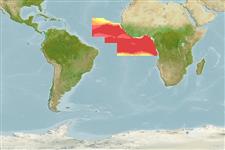Teleostei (teleosts) >
Argentiniformes (Marine smelts) >
Microstomatidae (Pencil smelts)
Eponymy: Fridtjof Nansen (1861–1930) was a Norwegian explorer, scientist, diplomat and later recipient of the Nobel Peace Prize. [...] (Ref. 128868), visit book page.
Environment: milieu / climate zone / depth range / distribution range
Ecology
Marine; pelagic-oceanic; depth range 0 - 580 m (Ref. 5123). Tropical; 20°N - 10°S
Eastern Atlantic.
Size / Weight / Age
Maturity: Lm ? range ? - ? cm
Max length : 16.8 cm SL male/unsexed; (Ref. 5123)
Short description
Identification keys | Morphology | Morphometrics
Dorsal soft rays (total): 9 - 10; Anal soft rays: 8 - 9; Vertebrae: 41 - 42. Branchiostegal 4. Pyloric caeca 7-9. Origin of dorsal fin base in front of center of the body. A dark pigment spot at adipose fin base (Ref. 5123).
Life cycle and mating behavior
Maturity | Reproduction | Spawning | Eggs | Fecundity | Larvae
Cohen, D.M., 1990. Argentinidae. p. 235-238. In J.C. Quero, J.C. Hureau, C. Karrer, A. Post and L. Saldanha (eds.) Check-list of the fishes of the eastern tropical Atlantic (CLOFETA). JNICT, Lisbon; SEI, Paris; and UNESCO, Paris. Vol. 1. (Ref. 4458)
IUCN Red List Status (Ref. 130435: Version 2024-1)
Threat to humans
Harmless
Human uses
Tools
Special reports
Download XML
Internet sources
Estimates based on models
Preferred temperature (Ref.
123201): 12.9 - 17.2, mean 15.6 °C (based on 33 cells).
Phylogenetic diversity index (Ref.
82804): PD
50 = 0.5000 [Uniqueness, from 0.5 = low to 2.0 = high].
Bayesian length-weight: a=0.00389 (0.00180 - 0.00842), b=3.12 (2.94 - 3.30), in cm total length, based on all LWR estimates for this body shape (Ref.
93245).
Trophic level (Ref.
69278): 3.3 ±0.4 se; based on size and trophs of closest relatives
Fishing Vulnerability (Ref.
59153): Low vulnerability (10 of 100).
